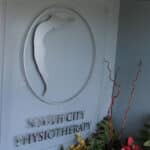Mechanical neck dysfunction is one of the most frequently treated conditions treated by physiotherapists. This condition may be the result of postural dysfunction, trauma such as an MVA, or it may be of insidious onset. Symptoms include pain, limited range of motion, radiculopathy and cervicogenic headaches.
The trend in physiotherapy has been towards evidence based practice. Recently (2004, 2007) a group of researchers with the Cochrane Collaboration and the Cervical Overview Group based at McMaster University in Hamilton performed a systematic review of the literature. They have described what research shows to be effective physiotherapy treatment for mechanical neck dysfunc-tion.
The best treatment is multimodal treatment
Both systematic reviews found that the most beneficial treatment for subacute or chronic mechanical neck dysfunction is a multimo-dal treatment approach of exercise plus mobilization and/or manipulation. Treatment effects were pain relief, increased functional abilities, and a strong global perceived effect of treatment (GPE). This was true for clients who did and did not experience cervico-genic headaches as part of their condition.
Manipulation and/or mobilization alone or combined with other types of treatment was found to be less effective for the treatment of mechanical neck disorders (1,2). Treatment techniques which were shown to have a strong or moderate treatment effect are sum-marized in the tables below.
In these tables, acute is defined as <30 days, subacute is 30-90 days, and chronic is >90 days. Mechanical neck pain is defined as including WAD I/II, with or without headaches, and with or without radicular findings
Strong Evidence of Treatment Effect
Moderate Evidence of Treatment Effect (2)
Mobilization and Manipulation
What is mobilization?
Mobilization is a low velocity, small or large amplitude passive movement technique or neuromuscular technique which creates movement within a joint. This movement is performed within the patient’s physiological range of cervical motion. The client is able to control this movement; he/she is able to actively prevent the physiotherapist from performing or continuing the movement (1).
What is manipulation?
Manipulation performed by qualified physiotherapists is a localized high velocity, low amplitude force directed at a joint segment (1). Manipulation has been shown to decrease muscular tone surrounding a joint (4); it is also thought to increase movement of a joint by affecting capsule stiffness, breaking adhesions, or freeing a fixated joint (fixated due to loose body, for example).
This technique is performed at end of range, and the client is not able to actively prevent the movement from occurring. Therefore, a series of safety tests are performed prior to considering performing the technique, informed consent is obtained prior to performing a manipulation, and a pre-manipulative hold is held at which time consent to proceed is obtained again. The client is informed that they may withdraw their consent at any time.
Which physiotherapists are qualified to perform spinal manipulation?
1. Physiotherapists who trained to perform spinal manipulation within the Canadian Orthopaedic Division of the Canadian Physio-therapy Association have the designation Dip.Manip and/or FCAMT.
2. Physiotherapists who have graduated with a Masters of Clinical Science in Manipulative Therapy from the University of Western Ontario.
3. Physiotherapists who have completed the full MDT program through the Robin McKenzie Institute
To earn their designations, these physiotherapists undergo rigorous, multi-level and multiple year educational programs, which in-cludes didactic and practical learning, and written, oral and practical examinations.
What exercises work?
A systematic review of the literature was recently performed by the Cervical Overview Group. A paper has been published outlining the exercises that have been shown to be most effective for the treatment of mechanical neck disorders (3). These exercises are a combination of exercises for local cervical spine stabilizers and more global exercises. An example of an isolation and endurance exercise for the deep neck flexors is shown below.
Exercise Instructions; Place head in neutral position using a pillow. Place tongue on roof of mouth. Without contracting large mus-cles on side of neck, track eyes down to toes. When eyes cannot track any further down, have the patient nod the head a small amount—thereby activating the short flexors of the neck. Hold, relax, and repeat.
Why use some of these treatment methods if they have not been shown to have a strong treatment effect?
Treatment modalities that result in short-term effects do have their place in a physiotherapy treatment program. When used in con-junction with other techniques that have been shown to provide long-term effects. For example, with some clients a predisposing factor is present which does not allow them to participate in the exercise program which is required to help correct their problem. However, the exercise is essential to correction of the problem. At these times, modalities which provide short-term pain relief or which temporarily reduce muscle tone may enable the client to perform the required exercise, which will then allow the overall condi-tion to improve, eliminating the need for the pain management treatment technique.
Mechanical neck dysfunction treatment programs must be individualized to client needs, and may incorporate various treatment modalities in order to obtain the desired effects.
References
Gross AR, Hoving JL, Haines TA, Goldsmith CH, Kay T, Aker P, Bronfort G, Cervical overview group, The Cochrane Collaboration. Manipulation and mobilization for mechanical neck disorders (Review).
Gross AR, Goldsmith, C, Hoving, JL, Haines T, Peloso P, Aker P, Santaguida P, Myers C, and the Cervical Overview Group. Con-servative Management of Mechanical Neck Disorders: A Systematic Review. The Journal of Rheumatology 2007; 34:3, 1083-102
Gross AR, McLaughlin L, Cervical Overview Group. Lecture notes from HaNSA meeting, McMaster University, 2008.
Sterling M, Jull G, Wright A. Cervical Mobilisation: concurrent effects on pain, sympathetic nervous system activity, and motor activ-ity. Manual Therapy 2001 6(2), p.72-81.








